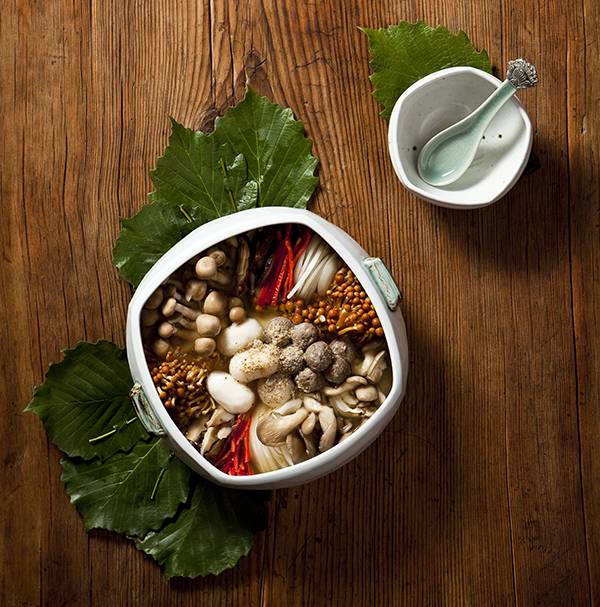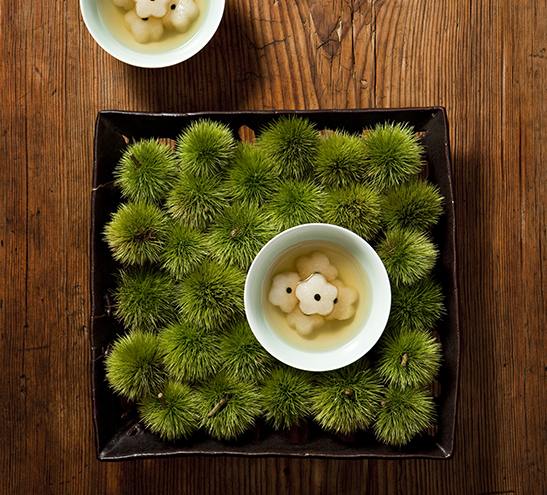한식 읽기 좋은 날
Vol 43. Harmony The Flavor and Beauty of Hansik
Chuseok Table Setting with Quaint Autumn Beauty
The Chuseok table, which is carefully prepared with fresh grains and fruits grown in the sunlight of the autumn, contains the wisdom of our ancestors who led healthy lives with seasonal food grown by nature. This article will introduce Chuseok food that will fill your heart like a round full moon.
Article. The Editorial Room Photo. Kim J Cooking & Styling. Yang Eun-sook
Taro Soup Chuseok Soup Dish
Since there is a record of boiling taro soup in the countryside in <Donggukisanggukjip>, it is estimated that taro soup has been eaten for a long time. It is not known exactly when taro soup began to be a part of Chuseok seasonal dishes. However, based on the phrase, “Let’s celebrate Chuseok holidays with pickled pollocks. Offer shindoju, olbyeo songpyeon, seasoned gourd, and taro soup in the family burial grounds, and share them with neighbors,” it is believed that taro soup has become a part of the seasonal food in the Joseon Dynasty.
As a method of boiling taro soup, <Siuijeonseo> states, “① Thoroughly scrape and wash the taro, ② then add meat, radish, and kelp, and boil thoroughly according to instructions.” There is also a phrase, “It’s good to add chicken.” <Gajeong Yori> advises that, “If you boil the taro once, rinse it in water, and soak in water with a drop of vinegar, it will not be slippery, and its astringent taste will disappear.”
Taro is cut into pieces to make soup, but <Joseon Moosang Sinsik Yori Jebeop> introduces another method of making taro soup. Taro is boiled, mashed, sifted through a sieve, and made into a meatball by mixing in the ground beef. The meatball is then coated with flour and egg, and pan-fried to make the taro soup.
For the broth of the taro soup, beef soup, clear soup, and tojangguk(thick soybean paste soup) are mainly used. Regarding the broth of taro soup, changes in the use of kelp stands out. Kelp was previously used for broth, but it gradually disappeared from the soup.
Mushroom Perilla Seed Taro Soup
Ingredients
200 g minced beef(1/2 tbsp soy sauce, 1 tsp sugar, 1 tsp chopped garlic, 1 tbsp chopped green onion, and a little bit of sesame oil and pepper), 4 soaked golden oak mushrooms, 100 g oyster mushroom, 100 g matari mushroom, mini king oyster mushroom and taro 120 g each, 1 onion, 1 red chili, 3 tbsp perilla powder, 1 egg white, 4 cups broth, and 3 tbsp soy sauce
How to make it
① Mix the beef with the seasoning, and make it into a ball. Coat it with the egg whites and pan-fry it slightly.
② Trim all the mushrooms, and tear them apart. Slice the onion and red chili.
③ Peel the taro, and soak it in water to remove the astringent taste.
④ Place the ingredients in a pot, and pour the broth and bring to a boil.
⑤ Season with soy sauce, and, at the end, add perilla seed powder and boil a little more.

Hwayangjeok Chuseok Nureumjeok(Pan-fried Skewers)
Hwayangjeok is a dish made by lightly stir-frying bellflower root, beef, carrots, mushrooms, and green onions, skewering them in colors, and pan-frying them again in oil. It is also called “nureumjeok,” “hwayang nurimi,” etc. Here, “hwayang” means bellflower root. Hwayangjeok is a type of food that values the harmony of overall color and shape, rather than nutritional aspects. It is made carefully so that the length and thickness of the food ingredients are well-proportioned, in addition to the brilliance of the five cardinal colors. Hwayangjeok in five cardinal colors were served on a king’s table, royal table, and banquet table. The ingredients used in a plate of hwayangjeok were served on the 60th birthday celebration of Crown Princess Hong that was recorded in <Wonhaeng Eulmyo Jeongri Uigwe>. These included 7 geuns(1 geun=about 600g) pork, 5 geuns pig heart meat, half lamb, 5 each of back bones and intestines, 1 gray mullet, 50 eggs, 7 abalones, 3 skewers of sea cucumbers, 5 does(1 doe = about 1.8 liters), 3 soks(sok = bundle) bellflower roots, 1 dan(bunch) of green onions, 2 does manna lichen, 1 doe golden oak mushroom, 1 don(= about 3.75g) and 5 poons(1 poon=1%) pepper, 1 hop(=180ml) of ganjang, and salt. Hwayangjeok is a type of nureumjeok in which the ingredients are neatly trimmed and coated in flour and egg, and then pan-fried in oil. After the 18th century, the method of seasoning different ingredients and cooking them, and skewering them in color orders appeared.
<Joseon Moosang Sinsik Yori Jebeop> stated, “Do not pan-fry the ones for weddings and banquets as it should be narrow in width and shorter in length than the pan-fried dish, and only skewer bellflower root, meat, green onions, and water parsley.” The hwayangjeok recipe introduced in <Ijo Goonjeong Yori Tonggo> states: ① Boil the raw bellflower roots in brine and cut it into 5 to 6 cm lengths. ② Season ① with pepper, sesame salt, green onion, and garlic, and stir-fry it in sesame seed oil. ③ Cut the beef into the same size as the bellflower root, season it with soy sauce, pepper, sesame salt, sugar, green onion, garlic, and sesame seed oil, and stir-fry it. ④ Cut the carrots into the same size as the bellflower root, and blanch it brine. ⑤ Mix all the above-mentioned ingredients with sesame oil, pine nut powder, and pepper, and skewer them in color order. ⑥ Serve hwayangjeok with different colored sanjeok. When serving hwayangjeok, soak it in the pine nut juice made from grinding pine nuts into the broth, or pine nut powder is sprinkled on top of the hwayangjeok.

Hwayangjeok
Ingredients
산적용 소고기 200g(간장 2큰술, 설탕 1작은술, 다진 마늘 1작은술, 다진 파 1큰술, 참기름·후추 약간), 오이·당근 각 1개, 달걀
노른자 6개, 통도라지 4뿌리, 불린 표고버섯 4장, 잣가루 1큰술, 소금·식용류 약간, 꼬치용 나무 12개
How to make it
① Cut the meat into 2-cm wide, 8-cm long, and 0.6-cm thick size, and marinate in the sauce.
② Oil the pan and wipe it with a kitchen tower, make the egg garnish over low heat, and cut it into 1.5-cm wide, 7-cm long, and 0.3-cm thick pieces.
③ Cut the whole bellflower roots, carrots, and cucumbers into the same size as ②, pickle them in salt water and blanch the bellflower roots and carrots in boiling water. Cut the soaked golden oak mushrooms into the same size.
④ Heat oil in a pan, and fry the bellflower roots, cucumber, carrot, mushroom, and meat in order.
⑤ Put the prepared ingredients on the skewers according to the color, and sprinkle the pine nut powder over them.
Baesook Chuseok Eumcheongryu(Non-alcoholic Beverages)
Baesook cannot be left as an umcheongryu for Chuseok. There are two methods of making baesook. <Siuijeonseo> introduces a method of peeling the pear clean, cutting it into quarters, removing the inside, pouring water to boil the pear, adding honey and boiling it more, and cooling it and serving it with pine nuts as garnish. In other cookbooks, the pear is cut into quarters, peel the skin, putting three to four whole peppercorns into the pear, and boil it in the honey water or sugar water with ginger.
<Joseon Moosang Sinsik Yori Jebeop> introduced both methods, and the description stated that the baesook made with whole peppercorns was a specialty that was made in the palace.
On the other hand, according to <Joseon Yoribeop>, if the pear color turns reddish and dark when it is done, one must be careful not to let the pear become too soft.
<Joseon Yori Jebeop> stated that peach, cherry, and apricot were prepared and eaten in the same way according to the season.
Baesook
Ingredients
1 pear, 2 ginger roots, 3 tbsp sugar, 20 peppercorns, 600 ml water
How to make it
① Pour water into a pot, add sliced ginger, bring it to a boil, and strain through a sieve.
② Divide the pear into 8 equal parts, cut out the seeds, mold it with a shape frame, and put peppercorns in it.
③ Put ginger water, sugar, and pears in a pot, and boil until the pear becomes transparent.
④ Cool it down and put it on the bowl.











